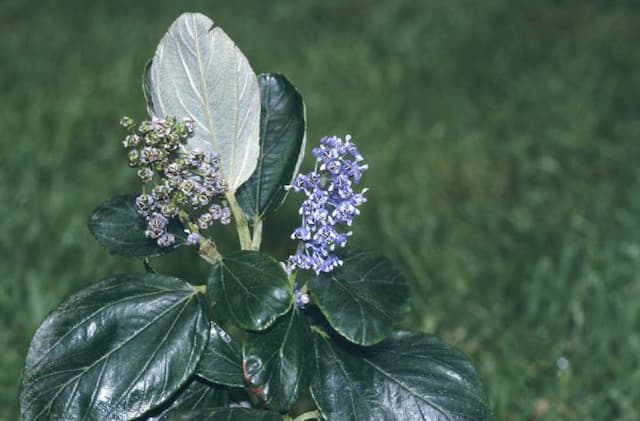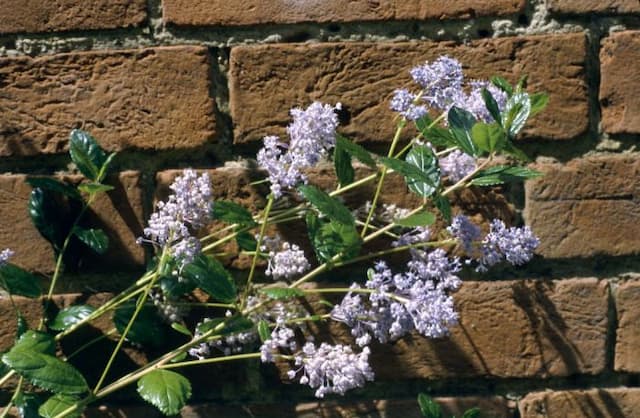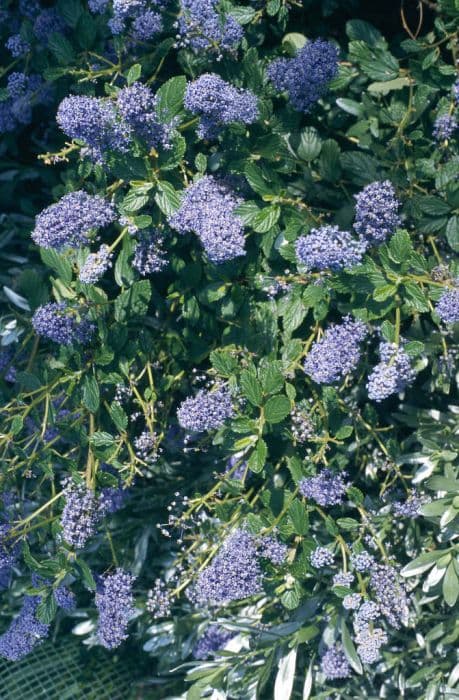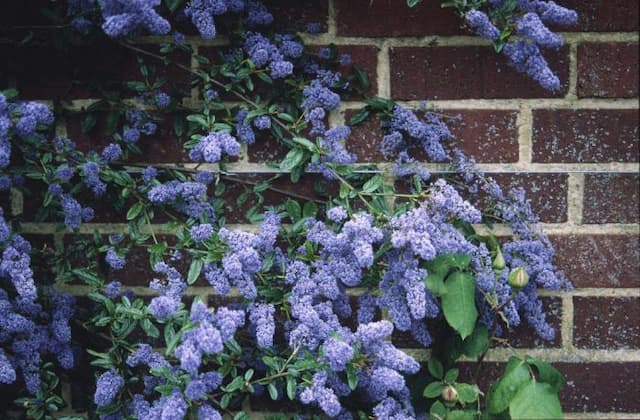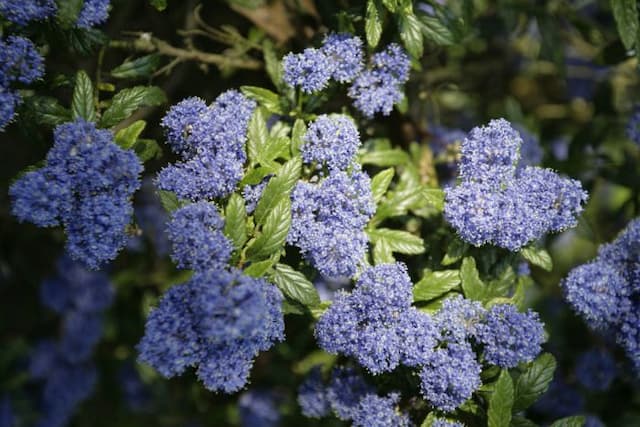California Lilac Ceanothus 'Blue Mound'
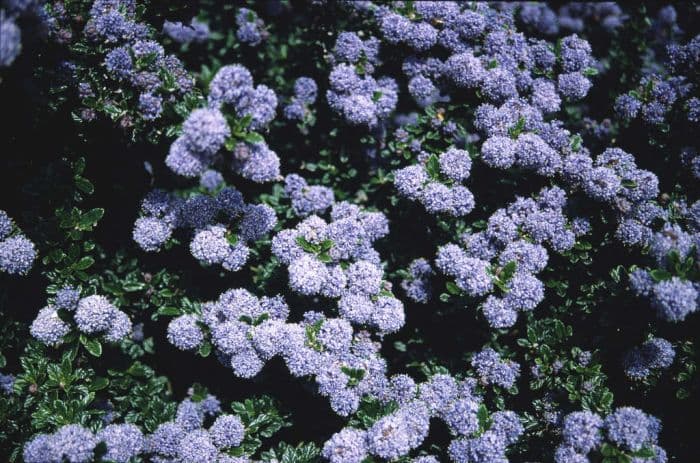
ABOUT
The Ceanothus 'Blue Mound', commonly known as California Lilac, is a striking garden shrub recognized for its dense and rounded form. Its appearance is characterized by lush, glossy green leaves which provide a perfect backdrop for the profusion of deep blue flowers that emerge. These blooms can be described as small but abundant, clustered together in eye-catching, rounded flower heads that seem to cover the plant in a veil of blue during the flowering season. The plant gives off a subtle, sweet fragrance that attracts various pollinators, enhancing its ornamental appeal. Overall, it bears a lush appearance that adds a vibrant splash of color to any garden setting.
About this plant
 Names
NamesFamily
Rhamnaceae
Synonyms
California Lilac, Blueblossom
Common names
Ceanothus thyrsiflorus 'Blue Mound'.
 Toxicity
ToxicityTo humans
Generally, California Lilac (Ceanothus 'Blue Mound') is not known for being toxic to humans. There is no substantial evidence to suggest that the California Lilac has any toxic effects when touched or ingested. However, as with many plants, individual allergic reactions are possible. It's always advisable to handle plants with care and avoid ingesting plant material.
To pets
California Lilac (Ceanothus 'Blue Mound') is not commonly listed as toxic to pets. There is limited information regarding its toxicity for animals, but there are no widespread reports of poisoning from this plant. As a precaution, it is always advisable to prevent pets from ingesting plants, as even non-toxic plants can cause gastrointestinal upset if eaten in large quantities.
 Characteristics
CharacteristicsLife cycle
Perennials
Foliage type
Evergreen
Color of leaves
Green
Flower color
Blue
Height
3 feet (0.91 meters)
Spread
5 feet (1.52 meters)
Plant type
Shrub
Hardiness zones
7
Native area
North America
Benefits
 General Benefits
General Benefits- Attracts Pollinators: Ceanothus 'Blue Mound' is known for attracting bees and butterflies, contributing to pollination in the garden.
- Drought Tolerance: Once established, it has good drought resistance, making it suitable for xeriscaping or low-water landscapes.
- Easy to Grow: This variety of California lilac is relatively easy to care for, needing minimal maintenance once established.
- Year-Round Interest: With evergreen foliage, it provides year-round greenery, while its vibrant blue flowers add a splash of color in the spring.
- Wildlife Friendly: Provides habitat and food for various species of wildlife, including birds and beneficial insects.
- Erosion Control: Its root system can help stabilize slopes and prevent soil erosion.
- Compact Size: 'Blue Mound' has a compact growth habit, making it suitable for small gardens or as part of a mixed border.
- Fast Growing: It grows fairly quickly, providing a landscape with a mature look in a relatively short period.
- Aesthetic Appeal: The deep blue flowers and dense foliage make it an attractive choice for ornamental use in gardens and parks.
 Medical Properties
Medical PropertiesThis plant is not used for medical purposes.
 Air-purifying Qualities
Air-purifying QualitiesThis plant is not specifically known for air purifying qualities.
 Other Uses
Other Uses- Ceanothus 'Blue Mound', commonly known as California Lilac, can be used as a natural dye; the flowers specifically can produce a range of blue and purple hues for fabrics.
- The dense foliage can provide excellent cover and nesting sites for small birds, promoting local biodiversity in a garden setting.
- When planted in mass, California Lilac can act as a soil stabilizer on slopes preventing erosion and landslides thanks to its extensive root system.
- Its dried flowers can be used in potpourri mixes, complementing other dried flowers and botanicals with its color and subtle fragrance.
- In bonsai culture, California Lilac can be trained as an ornamental dwarfed tree, prized for its compact form and stunning spring blossoms.
- Due to its dense growth, it can be used as a privacy screen, creating a natural, flowering barrier between properties or alongside roads.
- The hard wood of California Lilac can be used for making small wooden objects or for intricate woodworking projects.
- By planting California Lilac in urban and suburban areas, it serves as a nectar source for bees and butterflies, supporting pollinator populations.
- The aromatic leaves can be used to create scented sachets that can freshen up closets or drawers.
- As a subject in photography and painting, the vibrant blue flowers of California Lilac can provide a striking springtime imagery in artistic works.
Interesting Facts
 Feng Shui
Feng ShuiThe California Lilac is not used in Feng Shui practice.
 Zodiac Sign Compitability
Zodiac Sign CompitabilityThe California Lilac is not used in astrology practice.
 Plant Symbolism
Plant Symbolism- Endurance: Ceanothus, often known as California lilac, tends to be a hardy plant that can withstand tough conditions, symbolizing the ability to endure and persist.
- Resilience: California lilac often quickly recovers from pruning or damage, which translates symbolically to resilience and the ability to bounce back from challenges.
- Hope: With its bright blue flowers that appear in spring, California lilac is seen as a symbol of hope and inspiration, marking the end of winter and the beginning of a fruitful season.
- Self-Sufficiency: This plant is drought-tolerant, representing the quality of self-sufficiency or independence, as it can survive without much water or care.
 Water
WaterCalifornia Lilac (Ceanothus 'Blue Mound') requires moderate watering and should be watered deeply to encourage root growth, but the soil should be allowed to dry out between watering sessions. During the growing season, water approximately once a week with about 1 to 1.5 gallons per plant depending on the size and weather conditions, decreasing frequency in cooler months. Overwatering can lead to root rot, so ensure good drainage. It is more drought-tolerant once established, typically after a year or two, requiring less frequent watering unless there are extended periods of dry weather.
 Light
LightCalifornia Lilac thrives in full sun, meaning it requires at least six hours of direct sunlight daily. The best spot for this plant would be in an area where it's exposed to unfiltered sunlight for most of the day. It can tolerate partial shade, but flowering is optimal when the plant receives maximum sunlight.
 Temperature
TemperatureCalifornia Lilac tolerates a range of temperatures but thrives in conditions between 50°F and 70°F. It can survive minimum temperatures down to about 10°F and can withstand maximum temperatures up to around 100°F. Ensure the plant is protected from harsh winter winds which can damage it, especially if temperatures dip below freezing.
 Pruning
PruningPrune California Lilac to maintain shape and promote healthy growth. Pruning is best done immediately after flowering to avoid cutting off next year's buds, which form on old wood. It typically involves removing dead or crossing branches and can be pruned lightly every year or more heavily every few years. It's often pruned into a tree form or a rounded shrub.
 Cleaning
CleaningNot needed
 Soil
SoilThe California Lilac 'Blue Mound' thrives in well-draining soil with a low to moderate fertility level and prefers a soil pH that is slightly acidic to neutral, ranging from 5.5 to 7.5. A good soil mix for this plant could be a combination of loam, sand, and compost to ensure proper drainage and aeration.
 Repotting
RepottingCalifornia Lilac 'Blue Mound' is typically grown as an outdoor shrub and does not require frequent repotting. It should be repotted only if it outgrows its container or the soil becomes too compacted, which is generally every few years.
 Humidity & Misting
Humidity & MistingCalifornia Lilac 'Blue Mound' is adaptable to a wide range of humidity levels and usually thrives in the ambient outdoor humidity. It does not require any special humidity adjustments when grown in its preferred outdoor environment.
 Suitable locations
Suitable locationsIndoor
Place California Lilac in bright, indirect light indoors.
Outdoor
Plant in full sun, well-drained soil; mulch in winter.
Hardiness zone
7-10 USDA
 Life cycle
Life cycleThe life of a California lilac 'Blue Mound' (Ceanothus 'Blue Mound') begins with the germination of its seeds, which typically requires exposure to moist and warm conditions. Once germinated, the seedling will establish itself, developing roots and first leaves as it emerges from the soil. As it grows, 'Blue Mound' enters a vegetative state, where it focuses on developing a bushy structure covered with glossy green leaves. The next stage is the flowering period, which occurs in late spring to early summer, when it boasts profuse clusters of small, bright blue flowers that attract bees and butterflies. Following pollination, the plant produces seeds, which are then dispersed, ready to begin new life cycles. 'Blue Mound' is an evergreen shrub, so it maintains its leaves throughout the year, although growth may slow or pause during colder months before resuming in spring.
 Propogation
PropogationPropogation time
Spring-Early Summer
The California lilac 'Blue Mound' is commonly propagated using semi-hardwood cuttings, a process best done in late summer. To propagate by cuttings, one should select a healthy, non-flowering shoot and cut a 4 to 6-inch (10 to 15 cm) length, making sure to include at least a couple of leaf nodes. The bottom of the cutting should be trimmed just below a node, and the lower leaves should be removed. Then, the base of the cutting is often dipped in rooting hormone before being planted in a mixture of sand and peat or a perlite and peat blend to encourage root growth. The cutting should then be placed in indirect light and kept moist but not waterlogged. With proper care, roots will develop within several weeks, after which the new plants can eventually be transferred to a more permanent location.
